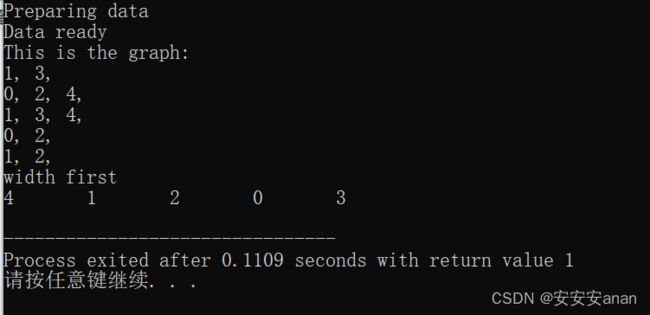数据结构----邻接表及广度优先遍历
图的表示:邻接表
邻接表结构原理
在邻接列表实现中,每一个顶点会存储一个从它这里开始的相邻边的列表。比如,如果顶点 B 有一条边到 A、C 和 E,那么 A 的列表中会有 3 条边。
邻接列表只描述指向外部的边。B 有一条边到 A,但是 A 没有边到 B,所以 B 没有出现在 A 的邻接列表中。
查找两个顶点之间的边或者权重会比较费时,因为遍历邻接列表直到找到为止。
完整代码
/*
Adjacency list for directed graph.
author Fan Min [email protected].
*/
#include
#include
#define QUEUE_SIZE 10
/*************** Copied code begins *****************/
int* visitedPtr;
/*
The structure of a graph.
*/
typedef struct Graph{
int** connections;
int numNodes;
} *GraphPtr;
/*
Initialize a graph.
*/
GraphPtr initGraph(int paraSize, int** paraData) {
int i, j;
GraphPtr resultPtr = (GraphPtr)malloc(sizeof(struct Graph));
resultPtr -> numNodes = paraSize;
//resultPtr -> connections = (int**)malloc(paraSize * paraSize * sizeof(int));
resultPtr -> connections = (int**)malloc(paraSize * sizeof(int*));
for (i = 0; i < paraSize; i ++) {
resultPtr -> connections[i] = (int*)malloc(paraSize * sizeof(int));
for (j = 0; j < paraSize; j ++) {
resultPtr -> connections[i][j] = paraData[i][j];
}//Of for j
}//Of for i
return resultPtr;
}//Of initGraph
/*
A queue with a number of indices.
*/
typedef struct GraphNodeQueue{
int* nodes;
int front;
int rear;
}GraphNodeQueue, *QueuePtr;
/*
Initialize the queue.
*/
QueuePtr initQueue(){
QueuePtr resultQueuePtr = (QueuePtr)malloc(sizeof(struct GraphNodeQueue));
resultQueuePtr->nodes = (int*)malloc(QUEUE_SIZE * sizeof(int));
resultQueuePtr->front = 0;
resultQueuePtr->rear = 1;
return resultQueuePtr;
}//Of initQueue
/*
Is the queue empty?
*/
bool isQueueEmpty(QueuePtr paraQueuePtr){
if ((paraQueuePtr->front + 1) % QUEUE_SIZE == paraQueuePtr->rear) {
return true;
}//Of if
return false;
}//Of isQueueEmpty
/*
Add a node to the queue.
*/
void enqueue(QueuePtr paraQueuePtr, int paraNode){
if ((paraQueuePtr->rear + 1) % QUEUE_SIZE == paraQueuePtr->front % QUEUE_SIZE) {
printf("Error, trying to enqueue %d. queue full.\r\n", paraNode);
return;
}//Of if
paraQueuePtr->nodes[paraQueuePtr->rear] = paraNode;
paraQueuePtr->rear = (paraQueuePtr->rear + 1) % QUEUE_SIZE;
}//Of enqueue
/*
Remove an element from the queue and return.
*/
int dequeue(QueuePtr paraQueuePtr){
if (isQueueEmpty(paraQueuePtr)) {
printf("Error, empty queue\r\n");
return NULL;
}//Of if
paraQueuePtr->front = (paraQueuePtr->front + 1) % QUEUE_SIZE;
//printf("dequeue %d ends.\r\n", paraQueuePtr->nodes[paraQueuePtr->front]);
return paraQueuePtr->nodes[paraQueuePtr->front];
}//Of dequeue
/*************** Copied code ends *****************/
/*
Aajacent node.
*/
typedef struct AdjacencyNode {
int column;
AdjacencyNode* next;
}AdjacencyNode, *AdjacentNodePtr;
/*
Aajacent list.
*/
typedef struct AdjacencyList {
int numNodes;
AdjacencyNode* headers;
}AdjacencyList, *AdjacencyListPtr;
/*
Construct an adjacent list.
*/
AdjacencyListPtr graphToAdjacentList(GraphPtr paraPtr) {
//Allocate space.
int i, j, tempNum;
AdjacentNodePtr p, q;
tempNum = paraPtr->numNodes;
AdjacencyListPtr resultPtr = (AdjacencyListPtr)malloc(sizeof(struct AdjacencyList));
resultPtr->numNodes = tempNum;
resultPtr->headers = (AdjacencyNode*)malloc(tempNum * sizeof(struct AdjacencyNode));
//Fill the data.
for (i = 0; i < tempNum; i ++) {
//Initialize headers.
p = &(resultPtr->headers[i]);
p->column = -1;
p->next = NULL;
for (j = 0; j < tempNum; j ++) {
if (paraPtr->connections[i][j] > 0) {
//Create a new node.
q = (AdjacentNodePtr)malloc(sizeof(struct AdjacencyNode));
q->column = j;
q->next = NULL;
//Link.
p->next = q;
p = q;
}//Of if
}//Of for j
}//Of for i
return resultPtr;
}//Of graphToAdjacentList
/*
Print an adjacent list.
*/
void printAdjacentList(AdjacencyListPtr paraPtr) {
int i;
AdjacentNodePtr p;
int tempNum = paraPtr->numNodes;
printf("This is the graph:\r\n");
for (i = 0; i < tempNum; i ++) {
p = paraPtr->headers[i].next;
while (p != NULL) {
printf("%d, ", p->column);
p = p->next;
}//Of while
printf("\r\n");
}//Of for i
}//Of printAdjacentList
/*
Width first tranverse.
*/
void widthFirstTranverse(AdjacencyListPtr paraListPtr, int paraStart){
printf("width first \r\n");
//Use a queue to manage the pointers
int i, j, tempNode;
AdjacentNodePtr p;
i = 0;
//Initialize data
visitedPtr = (int*) malloc(paraListPtr->numNodes * sizeof(int));
for (i = 0; i < paraListPtr->numNodes; i ++) {
visitedPtr[i] = 0;
}//Of for i
QueuePtr tempQueuePtr = initQueue();
printf("%d\t", paraStart);
visitedPtr[paraStart] = 1;
enqueue(tempQueuePtr, paraStart);
// printf("After enqueue\r\n");
while (!isQueueEmpty(tempQueuePtr)) {
// printf("First while\r\n");
tempNode = dequeue(tempQueuePtr);
for (p = &(paraListPtr->headers[tempNode]); p != NULL; p = p->next) {
j = p->column;
// printf("j = %d \r\n", j);
if (visitedPtr[j])
continue;
printf("%d\t", j);
visitedPtr[j] = 1;
enqueue(tempQueuePtr, j);
}//Of for
}//Of while
printf("\r\n");
}//Of widthFirstTranverse
/*
Test graph tranverse.
*/
void testGraphTranverse() {
int i, j;
int myGraph[5][5] = {
{0, 1, 0, 1, 0},
{1, 0, 1, 0, 1},
{0, 1, 0, 1, 1},
{1, 0, 1, 0, 0},
{0, 1, 1, 0, 0}};
int** tempPtr;
printf("Preparing data\r\n");
tempPtr = (int**)malloc(5 * sizeof(int*));
for (i = 0; i < 5; i ++) {
tempPtr[i] = (int*)malloc(5 * sizeof(int));
}//Of for i
for (i = 0; i < 5; i ++) {
for (j = 0; j < 5; j ++) {
//printf("i = %d, j = %d, ", i, j);
//printf("%d\r\n", tempPtr[i][j]);
tempPtr[i][j] = myGraph[i][j];
//printf("i = %d, j = %d, %d\r\n", i, j, tempPtr[i][j]);
}//Of for j
}//Of for i
printf("Data ready\r\n");
GraphPtr tempGraphPtr = initGraph(5, tempPtr);
AdjacencyListPtr tempListPtr = graphToAdjacentList(tempGraphPtr);
printAdjacentList(tempListPtr);
widthFirstTranverse(tempListPtr, 4);
}//Of testGraphTranverse
/*
Entrance.
*/
int main(){
testGraphTranverse();
return 1;
}//Of main
运行结果

